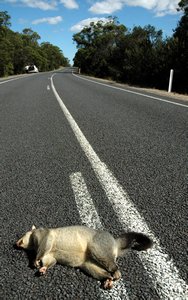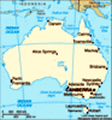Advertisement
Published: March 25th 2010

 Photo 3
Photo 3
One of the victims of Tassie's roadsAs the plane came in to land at Launceston's small airport, my view over the northern part of Tasmania was one of rolling pastures, distant hills and a small town nestled at the side of a large river. Tasmania sits off the coast of Victoria, one hour's flying time from Melbourne. Roughly the size of Ireland, it's a compact place where Nick and I would spend six nights. We collected our hire car from the airport and set off east, to start a circular route that would take us along the east coast to Hobart, then up the west coast via Cradle Mountain.
The first thing we noticed as we drove was the amount of roadkill. I'd heard stories from other people about the dangers of driving after dusk, but I wasn't prepared for just how true it was... seemingly every kilometre there was a dead animal... wallabies, pademelons, possums, echidnas... all manner of weird and wonderful (not to mention cute and furry!) Australian wildlife. It wasn't exactly how I wanted to see all of these amazing creatures, so we kept our eyes peeled for anything emerging from the bush and pushed on through the Midlands to the east coast.

 Photo 5
Photo 5
Stunning Wineglass BayOur first stop would be Coles Bay, a small town next to the Freycinet National Park which occupies the Freycinet Peninsula. Stopping briefly for lunch at pretty Bicheno, we arrived at Coles Bay mid afternoon and had a look around the bay's long white sand beach, before flaking out and catching up on some sleep.
Freycinet's main attraction is Wineglass Bay, a wonderfully picturesque semi-circular beach fringed by dense forest, with crystal clear water a strong torqouise in colour. Nobody quite knows how the bay got its name... it could be the shape, or maybe the way it used to be coloured red by all the whale blood from the whaling fleets cruising this part of the coast. Either way, it's a stunning part of the world. We did a short walk to the Wineglass Bay lookout (after seeing a wild wallaby in the car park), then down onto the beach for lunch and a quick swim (well, Nick had a dip... it was bloody freezing so I just watched!) before looping back across an isthmus to Hazards Beach and back around the headland to the car park. It was out first taste of the Australian natural landscape, and

 Photo 11
Photo 11
Historic Port Arthurwhat an introduction... bright red rocks, lots of eucalyptus trees and forests filled with the strange calls of hidden birds. After a short stop at a nearby lighthouse, we returned to the car and drove further south to the Tasman Peninsula, home to Tasmania's premier 'historic site', Port Arthur.
The role of convicts in Australia's history is well known, and Port Arthur on the Tasman Peninsula is one of the most prominent penal colonies. Convicts sentenced to transportation from Britain would first be sent to a prison on the mainland, and were only sent to Port Arthur if they re-offended once in Oz. It was therefore a home for the 'worst of the worst', at a time when Tasmania (then Van Diemen's Land) was a pretty remote and unwelcoming place. I have no doubt that there are some pretty harrowing stories to be told about Port Arthus, but we arrived to glorious sunshine which made the scattered ruins and pretty Victorian buildings seem altogether attractive, all the more so for their setting on a small bay backed with wooded mountains. I just couldn't get into the mindset of a convict being sent away from the squalor of 19th century

 Photo 15
Photo 15
A devil tug of warBritain to this... a tranquil land full of possibilities. What's left of Port Arthur, which ceased to be used as a prison in the 1850s, has been beautified and is now well managed and maintained, and for this it doesn't really convey the true experience or any of the horrors that were probably lived out here. Still, it was an engaging visit and after a morning wandering round we moved on to see the island's biggest attraction... those little devils.
Tassie Devils are under threat. A facial tumour disease is rapidly wiping them out, and so far attempts to find a cure have been unsuccessful. I believe that the responsible gene has now been identified, but the impact on the population has already been huge. Hence the presence of the Tasmanian Devil Conservation Park on the Tasman Peninsula. Their role is to protect this unique species, so we went along to see them in action. Luckily we arrived at feeding time. Before food these creatures are small, docile, vaguely cute little things which spend most of the time resting. But the arrival of food brings about as transformation... they grab whatever they can, snarl, bite, scratch and bite their

 Photo 20
Photo 20
A young kangaroo enjoys feeding timefellow devils to get a bite and will eat every single last scrap... including gristle, fur and bone. It was quite a thing to watch, as one devil grabbed the leg of the unidentified food (probably roadkill!) and ran off with it, followed closely be its mate. After doing a circuit of the pen (cue Benny Hill music as they ran along the ridge), they settled in a den and had a 15-minute tug of war, throwing up dust and straw as they went. Warner Brothers' portrayal wasn't too far from the truth! Looking for something a bit calmer, we went over to the kangaroo enclosure, and spent a happy half an hour hand-feeding Forrester kangaroos, including a small joey (when he wasn't hiding in his mum's pouch). The centre also had pademelons (small wallabies) and some birds of prey, and was about to begin an overhaul which would give more land over to the animals... bravo.
So, spare a thought for those poor little devils... and cross your fingers that a cure for their disease is found pretty soon.
Advertisement
Tot: 0.118s; Tpl: 0.015s; cc: 13; qc: 32; dbt: 0.0825s; 1; m:domysql w:travelblog (10.17.0.13); sld: 1;
; mem: 1.1mb























elJardineros
elJardineros
that's a terrible place for a squirrel to sleep :)